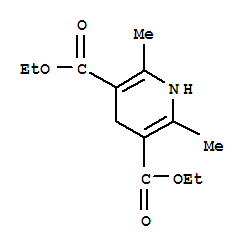- Min.Order :1 Metric Ton
- Purity: 98%-102%
- Payment Terms : L/C,T/T,
Keywords
DIETHYL 2,6-DIMETHYL-1,4-DIHYDROPYRIDINEDICARBOXYLATE 3,5-BIS(CARBOETHOXY)-2,6-DIMETHYL-1,4-DIHYDROPYRIDINE 2,6-DIMETHYL-1,4-DIHYDROPYRIDINE-3,5-DICARBOXYLIC ACID DIETHYL ESTER
Quick Details
- Appearance:light yellow powder or needle crystal
- Application:feed additive, Growth promoter
- PackAge:25KG/Carton or negotiable
- ProductionCapacity:200|Metric Ton|Month
- Storage:Keep away from light and air in dry warehouse, for two years
- Transportation:By Sea, Air, Express
Superiority:
Growth promoter
Antioxidation
Regulate secretion, enhance Serum Thyroid Hormone (T3)level
Improve immunity
Promote digestive absorption
Details:
|
Product Name: |
|
|
Synonyms: |
DILUDINE;DIETHYL 2,6-DIMETHYL-1,4-DIHYDRO-3,5-PYRIDINEDICARBOXYLATE; |
|
CAS: |
|
|
MF: |
C13H19NO4 |
|
MW: |
253.29 |
|
EINECS: |
214-561-6 |
|
Product Categories: |
Pharmaceutical Intermediates;Pyridines, Pyrimidines, Purines and Pteredines;C9 to C46;Heterocyclic Building Blocks;Pyridines;C9 to C46;Heterocyclic Building Blocks;fine chemicals, specialty chemicals, intermediates, electronic chemical, organic synthesis, pharmaceutical intermediates;Building Blocks;C13 to C15;Chemical Synthesis;Heterocycle-Pyridine series |
Appearance: light yellow powder or needle crystal
M.P.: 176℃-183℃
Assay: 98%-102%
Loss on drying: ≤0.5%
Residue: ≤0.5%
Heavy metal:≤ 10 ppm
Packing: 25 KG/Carton
Storage:Keep away from light and air in dry warehouse, for two years
| Name |
Diludine |
EINECS | 214-561-6 |
| CAS No. | 1149-23-1 | Density | 1.104 g/cm3 |
| Solubility | Melting Point | 176-183 °C | |
| Formula | C13H19NO4 | Boiling Point | 351.8 °C at 760 mmHg |
| Molecular Weight | 253.30 | Flash Point | 166.6 °C |
| Transport Information | Appearance | white power | |
| Safety | 26 | Risk Codes | 36/37/38 |
| Molecular Structure |
 |
Hazard Symbols |
 Xi Xi |
| Synonyms |
Diludine Specification
The Diludine with CAS registry number of 1149-23-1 is also known as Diethyl 1,4-dihydro-2,6-dimethyl-3,5-pyridinedicarboxylate. The IUPAC name is Diethyl 2,6-dimethyl-1,4-dihydropyridine-3,5-dicarboxylate. It belongs to product categories of Pharmaceutical Intermediates; Pyridines, Pyrimidines, Purines and Pteredines; C9 to C46; Heterocyclic Building Blocks; Pyridines;C9 to C46; Heterocyclic Building Blocks; Fine Chemicals, Specialty Chemicals, Intermediates, Electronic Chemical, Organic Synthesis, Pharmaceutical Intermediates. Its EINECS registry number is 214-561-6. In addition, the formula is C13H19NO4 and the molecular weight is 253.30. This chemical may cause inflammation to the skin or other mucous membranes. What's more, it is used as feed additive.
Physical properties about Diludine are: (1)ACD/LogP: 2.52; (2)# of Rule of 5 Violations: 0; (3)ACD/LogD (pH 5.5): 2.51; (4)ACD/LogD (pH 7.4): 2.51; (5)ACD/BCF (pH 5.5): 47.55; (6)ACD/BCF (pH 7.4): 48.01; (7)ACD/KOC (pH 5.5): 550.66; (8)ACD/KOC (pH 7.4): 555.99; (9)#H bond acceptors: 5; (10)#H bond donors: 1; (11)#Freely Rotating Bonds: 6; (12)Index of Refraction: 1.489; (13)Molar Refractivity: 66.18 cm3; (14)Molar Volume: 229.2 cm3; (15)Surface Tension: 35.7 dyne/cm; (16)Density: 1.104 g/cm3; (17)Flash Point: 166.6 °C; (18)Enthalpy of Vaporization: 59.66 kJ/mol; (19)Boiling Point: 351.8 °C at 760 mmHg; (20)Vapour Pressure: 4.01E-05 mmHg at 25 °C.
Preparation of Diludine: it is prepared by reaction of acetoacetic acid ethyl ester with formaldehyde. The reaction needs reagent NH4HCO3 and solvent H2O with other condition of heating for 30 minutes. The yield is about 86.3%.

Uses of Diludine: it is used to produce 2,6-dimethyl-pyridine-3,5-dicarboxylic acid diethyl ester. The reaction occurs with reagents silica chloride, NaNO2, SiO2/H2O and solvent CH2Cl2 at the temperature of 20 °C for 30 minutes. The yield is about 92%.

When you are using this chemical, please be cautious about it. As a chemical, it is irritating to eyes, respiratory system and skin. In case of contact with eyes, rinse immediately with plenty of water and seek medical advice.
You can still convert the following datas into molecular structure:
1. Canonical SMILES: CCOC(=O)C1=C(NC(=C(C1)C(=O)OCC)C)C
2. InChI: InChI=1S/C13H19NO4/c1-5-17-12(15)10-7-11(13(16)18-6-2)9(4)14-8(10)3/h14H,5-7H2,1-4H3
3. InChIKey: LJXTYJXBORAIHX-UHFFFAOYSA-N
The toxicity data is as follows:
| Organism | Test Type | Route | Reported Dose (Normalized Dose) | Effect | Source |
|---|---|---|---|---|---|
| dog | LD50 | oral | > 12gm/kg (12000mg/kg) | United States Patent Document. Vol. #4769382, | |
| mouse | LD50 | intraperitoneal | > 30gm/kg (30000mg/kg) | United States Patent Document. Vol. #4769382, | |
| mouse | LD50 | oral | > 32gm/kg (32000mg/kg) | U.S.S.R. Patent Document. Vol. #0546335, | |
| rat | LD50 | intraperitoneal | > 16gm/kg (16000mg/kg) | United States Patent Document. Vol. #4769382, |
You Might Also Like
Related Searches
About|Contact|Cas|Product Name|Molecular|Country|Encyclopedia
Message|New Cas|MSDS|Service|Advertisement|CAS DataBase|Article Data|Manufacturers | Chemical Catalog
©2008 LookChem.com,License: ICP
NO.:Zhejiang16009103
complaints:service@lookchem.com Desktop View